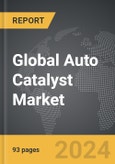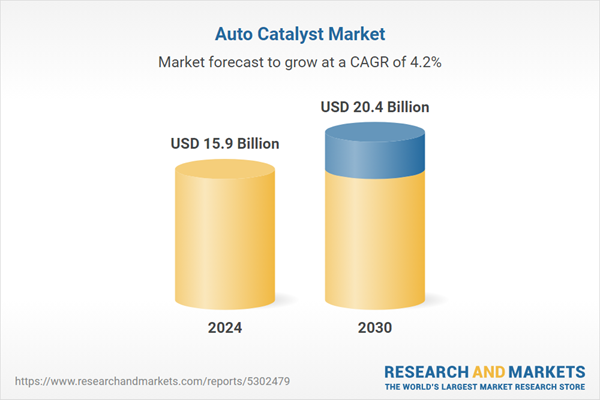The global market for Auto Catalyst was valued at US$15.9 Billion in 2024 and is projected to reach US$20.4 Billion by 2030, growing at a CAGR of 4.2% from 2024 to 2030. This comprehensive report provides an in-depth analysis of market trends, drivers, and forecasts, helping you make informed business decisions. The report includes the most recent global tariff developments and how they impact the Auto Catalyst market.
Segments: Product (Palladium, Platinum, Rhodium, Other Products); Application (Light-Duty Vehicle, Heavy-Duty Vehicle).
Geographic Regions/Countries: World; United States; Canada; Japan; China; Europe (France; Germany; Italy; United Kingdom; Spain; Russia; and Rest of Europe); Asia-Pacific (Australia; India; South Korea; and Rest of Asia-Pacific); Latin America (Argentina; Brazil; Mexico; and Rest of Latin America); Middle East (Iran; Israel; Saudi Arabia; United Arab Emirates; and Rest of Middle East); and Africa.
The analysts continuously track trade developments worldwide, drawing insights from leading global economists and over 200 industry and policy institutions, including think tanks, trade organizations, and national economic advisory bodies. This intelligence is integrated into forecasting models to provide timely, data-driven analysis of emerging risks and opportunities.
Global Auto Catalyst Market - Key Trends and Drivers Summarized
What Is an Auto Catalyst and How Does It Work?
An auto catalyst, commonly known as a catalytic converter, is a critical component in modern vehicles designed to reduce harmful emissions from the exhaust system. As cars burn fuel, they produce byproducts like carbon monoxide (CO), nitrogen oxides (NOx), and hydrocarbons (HC) which are major contributors to air pollution. The auto catalyst uses a catalytic process to convert these toxic gases into less harmful substances, such as carbon dioxide (CO2), nitrogen (N2), and water vapor (H2O), before they are released into the atmosphere. Auto catalysts typically consist of a honeycomb or ceramic substrate coated with a combination of precious metals like platinum, palladium, and rhodium. These metals act as catalysts, speeding up chemical reactions without being consumed themselves. When exhaust gases pass through the catalyst, they undergo two primary reactions: oxidation, which reduces hydrocarbons and carbon monoxide, and reduction, which tackles nitrogen oxides. This chemical conversion process occurs at high temperatures, enabling the catalyst to neutralize pollutants effectively. By transforming toxic emissions into relatively harmless byproducts, auto catalysts play a crucial role in reducing the environmental impact of automobiles and ensuring compliance with global emissions standards.What Sets Auto Catalysts Apart from Other Emission-Control Technologies?
Auto catalysts are unique in their ability to provide real-time, continuous emission control by chemically altering harmful pollutants directly within the vehicle's exhaust system. Unlike other emission control technologies, which may capture or filter emissions, auto catalysts transform toxic compounds through chemical reactions, making them highly effective in reducing the environmental footprint of vehicles. This capability allows auto catalysts to meet strict regulatory standards without requiring significant changes to vehicle design or fuel types. Unlike selective catalytic reduction (SCR) systems, which require urea-based additives for diesel engines, or particulate filters used to capture solid emissions, auto catalysts operate independently and don’t require additional chemicals to neutralize exhaust gases. This self-contained functionality is particularly valuable in gasoline-powered vehicles, where auto catalysts have been standard for decades. Advances in catalyst technology, such as high-performance coatings and nano-sized precious metal particles, have further enhanced their efficiency, making them lighter, more durable, and better suited to manage the increasingly stringent emissions standards worldwide. By continuously improving and innovating, auto catalysts remain a cornerstone of emissions control technology, balancing performance and environmental responsibility within a single, compact device.How Are Auto Catalysts Transforming the Automotive Industry?
Auto catalysts have fundamentally transformed the automotive industry by enabling vehicles to meet stricter environmental regulations while still delivering high performance. As emissions standards have become more stringent in regions like Europe, North America, and Asia, automakers have had to incorporate increasingly efficient catalysts into their designs to meet compliance. This push for lower emissions has driven significant innovation in catalytic materials and structures, allowing for lighter, more durable, and more efficient catalysts that perform effectively over the lifespan of the vehicle. Auto catalysts are not only crucial for gasoline engines but also play a key role in hybrid and diesel vehicles, where advanced catalysts are used to tackle unique emissions challenges. The impact of auto catalysts extends beyond regulatory compliance, however, as they have prompted a shift towards greener, more fuel-efficient technologies within the industry. As consumer awareness of environmental issues has grown, automakers have responded by designing vehicles with advanced catalytic systems that significantly reduce emissions without compromising power or fuel economy. In emerging markets, where urban air quality is a pressing concern, auto catalysts are increasingly used to curb pollution, thereby supporting global efforts to improve air quality and reduce greenhouse gas emissions. Through continuous innovation, auto catalysts have become a central component of sustainable automotive technology, pushing the industry towards a cleaner, more environmentally conscious future.What’s Driving the Growth of the Auto Catalyst Market?
The growth in the auto catalyst market is fueled by a combination of regulatory pressure, technological advancements, and rising environmental awareness among consumers and manufacturers. Governments worldwide are implementing stricter emissions standards to address air quality issues and reduce greenhouse gas emissions, which has spurred demand for more advanced catalytic converters in both new and existing vehicles. Technological innovations, such as the use of nano-materials and enhanced precious metal formulations, have increased catalyst efficiency and durability, making them more attractive to manufacturers looking to meet emissions standards without adding weight or sacrificing vehicle performance. The increasing adoption of hybrid and electric vehicles with internal combustion engines also drives the demand for specialized catalysts, as hybrid systems often operate under varying temperature conditions that require more resilient and adaptable catalytic solutions. Additionally, consumer demand for eco-friendly vehicles is on the rise, as buyers prioritize cars that minimize environmental impact while maintaining high performance. The expanding automotive market in emerging economies has further accelerated demand, as these regions work to improve urban air quality and align with international emissions standards. The combination of regulatory, technological, and consumer-driven factors is positioning the auto catalyst market for sustained growth, with ongoing developments expected to enhance catalyst efficiency and expand their applications as part of the automotive industry’s broader move towards sustainable and low-emission technologies.Report Scope
The report analyzes the Auto Catalyst market, presented in terms of units. The analysis covers the key segments and geographic regions outlined below.Segments: Product (Palladium, Platinum, Rhodium, Other Products); Application (Light-Duty Vehicle, Heavy-Duty Vehicle).
Geographic Regions/Countries: World; United States; Canada; Japan; China; Europe (France; Germany; Italy; United Kingdom; Spain; Russia; and Rest of Europe); Asia-Pacific (Australia; India; South Korea; and Rest of Asia-Pacific); Latin America (Argentina; Brazil; Mexico; and Rest of Latin America); Middle East (Iran; Israel; Saudi Arabia; United Arab Emirates; and Rest of Middle East); and Africa.
Key Insights:
- Market Growth: Understand the significant growth trajectory of the Palladium segment, which is expected to reach US$9.9 Billion by 2030 with a CAGR of a 4.7%. The Platinum segment is also set to grow at 4.2% CAGR over the analysis period.
- Regional Analysis: Gain insights into the U.S. market, valued at $4.2 Billion in 2024, and China, forecasted to grow at an impressive 6.0% CAGR to reach $4.1 Billion by 2030. Discover growth trends in other key regions, including Japan, Canada, Germany, and the Asia-Pacific.
Why You Should Buy This Report:
- Detailed Market Analysis: Access a thorough analysis of the Global Auto Catalyst Market, covering all major geographic regions and market segments.
- Competitive Insights: Get an overview of the competitive landscape, including the market presence of major players across different geographies.
- Future Trends and Drivers: Understand the key trends and drivers shaping the future of the Global Auto Catalyst Market.
- Actionable Insights: Benefit from actionable insights that can help you identify new revenue opportunities and make strategic business decisions.
Key Questions Answered:
- How is the Global Auto Catalyst Market expected to evolve by 2030?
- What are the main drivers and restraints affecting the market?
- Which market segments will grow the most over the forecast period?
- How will market shares for different regions and segments change by 2030?
- Who are the leading players in the market, and what are their prospects?
Report Features:
- Comprehensive Market Data: Independent analysis of annual sales and market forecasts in US$ Million from 2024 to 2030.
- In-Depth Regional Analysis: Detailed insights into key markets, including the U.S., China, Japan, Canada, Europe, Asia-Pacific, Latin America, Middle East, and Africa.
- Company Profiles: Coverage of players such as BASF SE, AP Exhaust Products, Inc., Bosal International N.V., Cataler Corporation, Corning Incorporated and more.
- Complimentary Updates: Receive free report updates for one year to keep you informed of the latest market developments.
Some of the 42 companies featured in this Auto Catalyst market report include:
- BASF SE
- AP Exhaust Products, Inc.
- Bosal International N.V.
- Cataler Corporation
- Corning Incorporated
- Cummins Emission Solutions, Inc.
- DCL International
- Faurecia S.A.
- Heraeus Holding GmbH
- Ibiden Co., Ltd.
Tariff Impact Analysis: Key Insights for 2025
Global tariff negotiations across 180+ countries are reshaping supply chains, costs, and competitiveness. This report reflects the latest developments as of April 2025 and incorporates forward-looking insights into the market outlook.The analysts continuously track trade developments worldwide, drawing insights from leading global economists and over 200 industry and policy institutions, including think tanks, trade organizations, and national economic advisory bodies. This intelligence is integrated into forecasting models to provide timely, data-driven analysis of emerging risks and opportunities.
What’s Included in This Edition:
- Tariff-adjusted market forecasts by region and segment
- Analysis of cost and supply chain implications by sourcing and trade exposure
- Strategic insights into geographic shifts
Buyers receive a free July 2025 update with:
- Finalized tariff impacts and new trade agreement effects
- Updated projections reflecting global sourcing and cost shifts
- Expanded country-specific coverage across the industry
Table of Contents
I. METHODOLOGYII. EXECUTIVE SUMMARY2. FOCUS ON SELECT PLAYERSIII. MARKET ANALYSISSOUTH KOREAREST OF ASIA-PACIFICARGENTINABRAZILMEXICOREST OF LATIN AMERICAIRANISRAELSAUDI ARABIAUNITED ARAB EMIRATESREST OF MIDDLE EASTIV. COMPETITION
1. MARKET OVERVIEW
3. MARKET TRENDS & DRIVERS
4. GLOBAL MARKET PERSPECTIVE
UNITED STATES
CANADA
JAPAN
CHINA
EUROPE
FRANCE
GERMANY
ITALY
UNITED KINGDOM
SPAIN
RUSSIA
REST OF EUROPE
ASIA-PACIFIC
AUSTRALIA
INDIA
LATIN AMERICA
MIDDLE EAST
AFRICA
Companies Mentioned (Partial List)
A selection of companies mentioned in this report includes, but is not limited to:
- BASF SE
- AP Exhaust Products, Inc.
- Bosal International N.V.
- Cataler Corporation
- Corning Incorporated
- Cummins Emission Solutions, Inc.
- DCL International
- Faurecia S.A.
- Heraeus Holding GmbH
- Ibiden Co., Ltd.
Table Information
| Report Attribute | Details |
|---|---|
| No. of Pages | 93 |
| Published | April 2025 |
| Forecast Period | 2024 - 2030 |
| Estimated Market Value ( USD | $ 15.9 Billion |
| Forecasted Market Value ( USD | $ 20.4 Billion |
| Compound Annual Growth Rate | 4.2% |
| Regions Covered | Global |









